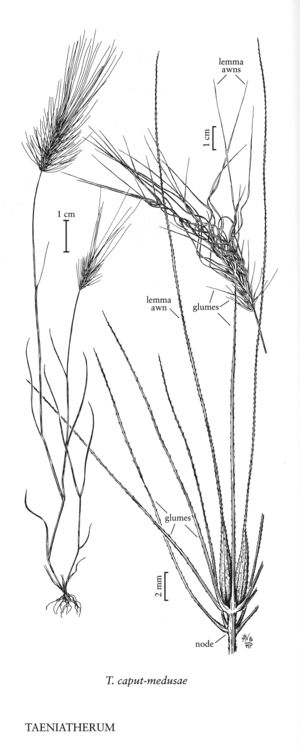Taeniatherum caput-medusae
Culms (5) 10-55 (70) cm. Auricles 0.1-0.5 mm, rarely absent; ligules 0.2-0.6 mm; blades (0.2) 0.7-2.5 mm wide, flat to involute. Spikes 1.2-6 cm. Spikelets 6-45 mm; glumes (5) 7-80 mm, awnlike, erect to reflexed. Bisexual florets: lemmas 5.5-8 mm, awns (20) 30-110 mm, divergent; anthers 0.8-1 mm. Caryopses 4-5.2 mm. 2n = 14.
Discussion
Taeniatherum caput-medusae is native from Portugal and Morocco east to Kyrgyzstan. It usually grows on stony soils, and flowers from May–June (July). It is an aggressive invader of disturbed sites in the western United States, where it has become a serious problem on rangelands. It has been found as a rare introduction at several sites in the eastern United States, but may not persist there. It is listed as a noxious weed by the U.S. Department of Agriculture.
Frederiksen (1986) recognized three subspecies within Taeniatherum caput-medusae, distinguishing among them on the basis of morphology and geography. Plants in the Flora region belong to Taeniatherum caput-medusae (L.) Nevski subsp. caput-medusae. It differs from the other two subspecies in its longer glumes and shorter lemmas.
Selected References
None.
Lower Taxa
"decumbent" is not a number.
